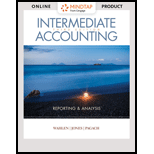
INTERM.ACCT.:REPORTING...-CENGAGENOWV2
3rd Edition
ISBN: 9781337909358
Author: WAHLEN
Publisher: CENGAGE L
expand_more
expand_more
format_list_bulleted
Question
Chapter 19, Problem 2C
1.
To determine
Explain the meaning of qualified pension plan and explain the manner in which a qualified pension plan would differ from a non-qualified plan.
2.
To determine
Explain the types of assumptions that are necessary to account the defined benefit pension plan, and explain whether the assumptions are also needed for a defined contribution.
3.
To determine
Describe the way in which Company C should estimate the service cost component of the net pension cost.
4.
To determine
Describe the way in which Company C should estimate the interest cost component of the net pension cost.
5.
To determine
Explain the manner in which company C should estimate the expected return on plan assets component of the net pension cost.
Expert Solution & Answer
Want to see the full answer?
Check out a sample textbook solution
Students have asked these similar questions
Financial accounting
I want to this question answer for General accounting question not need ai solution
Calculate the ending total assets balance
Chapter 19 Solutions
INTERM.ACCT.:REPORTING...-CENGAGENOWV2
Ch. 19 - Prob. 1GICh. 19 - Prob. 2GICh. 19 - Prob. 3GICh. 19 - Prob. 4GICh. 19 - Prob. 5GICh. 19 - Prob. 6GICh. 19 - Prob. 7GICh. 19 - Prob. 8GICh. 19 - Prob. 9GICh. 19 - Prob. 10GI
Ch. 19 - Prob. 11GICh. 19 - Prob. 12GICh. 19 - Prob. 13GICh. 19 - Prob. 14GICh. 19 - Prob. 15GICh. 19 - Prob. 16GICh. 19 - Prob. 17GICh. 19 - Prob. 18GICh. 19 - Prob. 19GICh. 19 - Prob. 20GICh. 19 - Prob. 21GICh. 19 - Prob. 22GICh. 19 - Prob. 23GICh. 19 - The actuarial present value of all the benefits...Ch. 19 - Prob. 2MCCh. 19 - Prob. 3MCCh. 19 - Prob. 4MCCh. 19 - Prob. 5MCCh. 19 - Prob. 6MCCh. 19 - Which of the following is not a component of...Ch. 19 - Prob. 8MCCh. 19 - Prob. 9MCCh. 19 - Prob. 10MCCh. 19 - Prob. 1RECh. 19 - Prob. 2RECh. 19 - Pinecone Company has plan assets of 500,000 at the...Ch. 19 - Prob. 4RECh. 19 - Prob. 5RECh. 19 - Prob. 6RECh. 19 - Prob. 7RECh. 19 - Prob. 8RECh. 19 - Given the following information for Tyler Companys...Ch. 19 - At the beginning of Year 1, Cactus Company has...Ch. 19 - Prob. 11RECh. 19 - Prob. 1ECh. 19 - Prob. 2ECh. 19 - Prob. 3ECh. 19 - Prob. 4ECh. 19 - Prob. 5ECh. 19 - Prob. 6ECh. 19 - Prob. 7ECh. 19 - Prob. 8ECh. 19 - Prob. 9ECh. 19 - Prob. 10ECh. 19 - Prob. 11ECh. 19 - Prob. 12ECh. 19 - Prob. 13ECh. 19 - Refer to the information provided in E19-13....Ch. 19 - Prob. 15ECh. 19 - Prob. 16ECh. 19 - Prob. 1PCh. 19 - Prob. 2PCh. 19 - Prob. 3PCh. 19 - Prob. 4PCh. 19 - Prob. 5PCh. 19 - Prob. 6PCh. 19 - Prob. 7PCh. 19 - Prob. 8PCh. 19 - Prob. 9PCh. 19 - Prob. 10PCh. 19 - Prob. 11PCh. 19 - Prob. 12PCh. 19 - Prob. 1CCh. 19 - Prob. 2CCh. 19 - Prob. 3CCh. 19 - Prob. 4CCh. 19 - Prob. 5CCh. 19 - Prob. 6CCh. 19 - Prob. 7CCh. 19 - Prob. 9C
Knowledge Booster
Similar questions
- Kepler Manufacturing has $18,000 of ending finished goods inventory as of December 31, 2023. If beginning finished goods inventory was $8,000 and the cost of goods sold (COGS) was $55,000, how much would Kepler report for cost of goods manufactured?arrow_forwardWhat is the total amount of property , plant and equipment that will appear on the balance sheet?arrow_forwardHi expert please given correct answer with accounting questionarrow_forward
- Hello tutor please given General accounting question answer do fast and properly explain all answerarrow_forwardGiven answer with step by step calculationarrow_forwardAt the beginning of the year, Elevator Manufacturing estimates the following manufacturing costs for the next period: direct labor, $940,000; direct materials, $610,000; and factory overhead, $282,000. 1. Compute its predetermined overhead rate as a percent of direct labor. 2. Compute its overhead cost as a percent of direct materials.arrow_forward
arrow_back_ios
SEE MORE QUESTIONS
arrow_forward_ios
Recommended textbooks for you
 Intermediate Accounting: Reporting And AnalysisAccountingISBN:9781337788281Author:James M. Wahlen, Jefferson P. Jones, Donald PagachPublisher:Cengage Learning
Intermediate Accounting: Reporting And AnalysisAccountingISBN:9781337788281Author:James M. Wahlen, Jefferson P. Jones, Donald PagachPublisher:Cengage Learning


Intermediate Accounting: Reporting And Analysis
Accounting
ISBN:9781337788281
Author:James M. Wahlen, Jefferson P. Jones, Donald Pagach
Publisher:Cengage Learning
